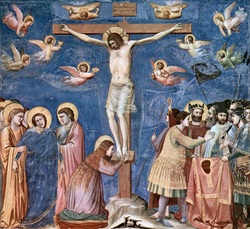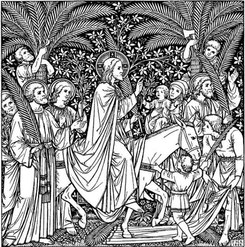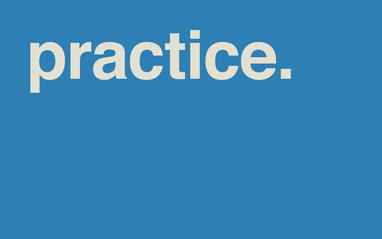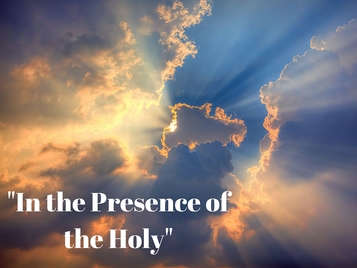 We gather today in the shadow of the Cross. These days, the Cross is something we often make pretty. Some of you here are wearing gold or silver crosses around your necks, perhaps with a jewel or a design on them. Or some of you might have a crucifix on, a cross that includes the figure of Jesus, similar to the one on our rood screen. Often these, too, are elegant and stylized. One popular version, a design that’s associated with St. Francis, pictures Jesus surrounded by brightly colored saints. The one over the doors in our Great Hall, which is called a Christus Rex, shows Jesus as a priest and king, reigning over the universe from the Cross. The Cross is also the subject of some of the most famous works of art in history: Giotto’s Crucifixion all in blue with angels flying around, Velazquez’ version where Jesus’ skin seems almost radiant in the blackness that envelops him. There are crosses made by artists in Central America that picture colorful peasant villages; crosses that look like flowers; crosses that are so perfectly symmetrical and stylized that you have to look at them for a few minutes to realize they even are crosses at all. Well, the wooden cross at the altar today is much more realistic. The real cross was big and heavy, enough to bear the weight of a grown man, a criminal. Surely the wood was rough, surely it was filthy, and definitely, to everyone who saw it, the Cross meant crime, and capital punishment, and condemnation. It sent the message that those who were at the top of the political heap could and would exclude and batter and crush those who opposed them. Anyone who lived at the time crucifixion was used as a method of torture and execution would be deeply shocked, I’m sure, to see us admiring priceless artworks about it, or wearing crosses around our necks. The Cross was meant to be evil. It was meant to kill hope, like every act of terror is. It was meant to shock and maim and destroy. It was meant, above all, to make sure that Jesus Christ would never trouble the powers that be again. To make sure that his followers would get the message: your little religious fantasy is nice, but don’t forget who’s really in charge. Don’t forget how things really are. But it didn’t work. It didn’t work, because things are actually not the way the powers that be think they are. They are the way God makes them. Love is stronger than hate, so what the powers that be tried to do by killing Jesus didn’t work. It didn’t work, because God’s ability to bring good is always more than ours to bring evil. It didn’t work, because rather than let that unjust suffering stay meaningless, instead God chose to enter all the way into it. Into all suffering, really, everywhere, for all time: into the maimed bodies, the spilled blood, the ethnic slurs, the hate of the mob, to enter into all of it, forever, and absorb it freely into himself. He did it 2000 years ago in Jerusalem, he did it earlier this week in Brussels, and he’s doing it right now for you and me, to carry our guilt and shame and cleanse us completely. And once he’s done that – well, perhaps we shouldn’t speak the word today, but you know as well as I do what happened on Easter morning. And because of that, even on this mournful day in the shadow of the Cross, we can give thanks. We can give thanks, as the words of our Prayer Book put it, that God “by the passion of his blessed Son made an instrument of shameful death to be for us the means of life.” If the cross were only one of history’s cruelest forms of state sanctioned murder, if the story ended with Jesus’ unjust, bloody death, there would be no reason to venerate the Cross today. No reason to be here at all. But condemnation and loss and death are not the end of the story. Not the story of Jesus, and thanks to him, not our stories either. See, it’s really no wonder we turn our crosses into thrones for a King. It’s no wonder we enhance them with gold and jewels, or paint them with bright colors of joy. We have to make our crosses beautiful, because even on this day we know the truth: through the power of the Cross of Christ, everything else can be made beautiful too.
0 Comments
 After hearing the great narrative of the Passion of Christ, as a preacher, I always feel superfluous. So I am just going to make a few comments this morning. In our first reading today, the servant of God that Christians identify with Jesus says through Isaiah, “the Lord God helps me; I know that I shall not be put to shame; he who vindicates me is near.” And in our second reading Paul clarifies what vindication it is that the prophet was talking about: “At the name of Jesus every knee should bow, and every tongue confess that Jesus Christ is Lord, to the glory of God the Father.” We proclaim that vindication today and every Palm Sunday. We say these words each year. Every knee shall bow. Every tongue shall confess. What I want us to ask ourselves about that is: why today? Palm Sunday is when we walk the whole road of Holy Week in miniature. Yes, there’s still Maundy Thursday and Good Friday to come. But we already heard about Jesus’ condemnation and crucifixion this morning. The Gospel we read left us at the point in the story where all we have left to put our faith in is a dead body, still nailed on a cross, with darkness over the whole land. So why, on a day like this, meditate on how Isaiah and Paul proclaim the vindication, the universal Lordship of Christ? Why not read about abandonment on this day when Jesus was abandoned by those who swore to stay by him? Why not read about failure, when today his power, at least as far as human eyes could see, failed when it was needed most? Why read instead that Christ is Lord today, which must be one of the harder days to believe it? Today Jesus is at the lowest point a human being can go. And yet we proclaim that God has vindicated him by raising him from death, even death on a Cross, and given him the name that is above every name.  Today is the last in our Lenten series of sermons on Episcopal basics. You'll remember that we began by talking about being a Christian, then about choosing the Episcopal community as the one which will support you in your choice to follow Christ, then about some of the special characteristics of this congregation in particular. And this final sermon will talk about putting it into practice. Practice, what we actually do routinely in real life situations, shows a lot about us. Kathleen Norris, a poet and essayist, has written, "I firmly believe that the way we bathe a child or discuss family matters at the dinner table reveals who our God is." Not only does that reveal who someone’s God is, it reveals it much more honestly than what we might tell a pollster when asked to name our religious affiliation. The easiest way to figure out who you actually worship, is to look at your actual attitudes and priorities, day by day. So we’re talking today about the practices, the habits, that help us treat the God who took flesh in Jesus as the God we actually worship. And in a sense this fourth sermon comes back to the first one. Because while there is an Episcopal style, all our baseline practices are shared widely with other Christians; the differences are mainly ones of emphasis. Daily prayer, weekly Eucharist, regular service in Christ’s name, regular patterns of giving, regular reading of the Scriptures, regular seeking of God’s guidance – you could make a longer list, but those are practices all Christians engage in.  Today we continue in our series of sermons on Anglican Basics and my topic is “Being an Episcopal Christian at Emmanuel”. Having worshipped in this particular Episcopal community for nearly 45 years it is hard to know where to begin, or more importantly, where to end! It’s just that I have so many stories from so many years. There have been many wonderful people who sat in these pews before, as well as many wonderful people who still are here. In all honesty the people are a large portion of what makes each “Eucharistic community” unique. That is our Bishop’s term for the churches in the diocese, “Eucharistic communities”. Episcopal and Bishop come from the same root word and that is part of what defines us as a denomination. All Episcopal churches respect and follow their Bishop. Emmanuel is a part of the Diocese of Springfield, geographically the area of Illinois east of Peoria, south of I-80 to the southern tip of the state. The diocese is known as a traditional and more orthodox part of the Episcopal Church. Emmanuel is well respected in the diocese by both clergy and laity. Through the years, members of this parish have served in many leadership roles such as Department Chairs of Evangelism, Christian education, Stewardship, Communication, Anti-Racism, and other positions such as Trustees, Commission on Ministry, Standing Committee, Deans and more. Each year at the annual meeting of the diocese, the Synod, Emmanuel sends elected delegates to participate in diocesan decisions. The polity of the church defines all of these responsibilities in its constitution and canons. If you are interested, there are many opportunities to read more about it. This morning I mention it to say that we at Emmanuel are a part of the larger church and that we take the responsibility that goes with that seriously. When the Bishop calls, the answer is almost always yes unless you have a very good reason to decline! So how best for me to focus my remarks this morning? I have decided to speak about some of the things that I see as characteristics of Emmanuel. |
Archives
July 2024
Categories |

 RSS Feed
RSS Feed